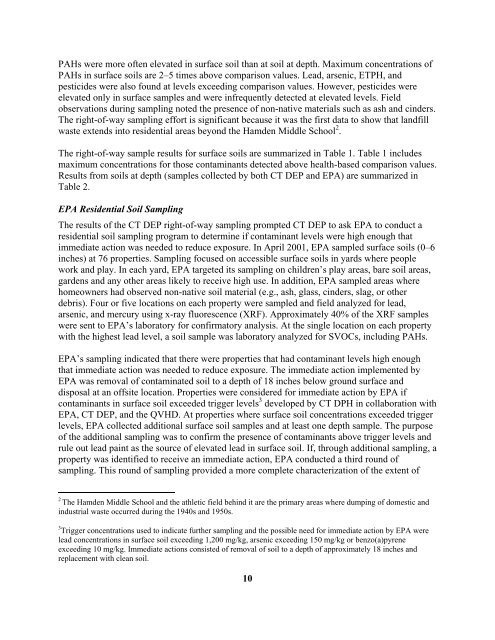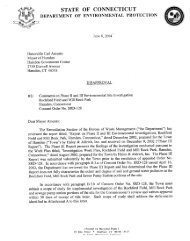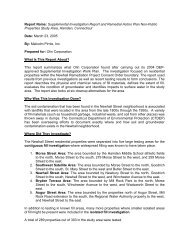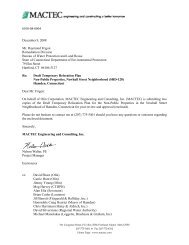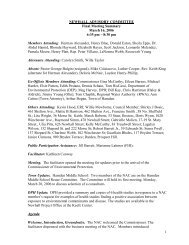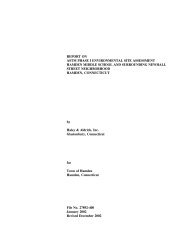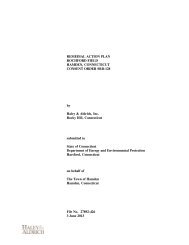Main Report - Newhall Remediation Project
Main Report - Newhall Remediation Project
Main Report - Newhall Remediation Project
- No tags were found...
Create successful ePaper yourself
Turn your PDF publications into a flip-book with our unique Google optimized e-Paper software.
PAHs were more often elevated in surface soil than at soil at depth. Maximum concentrations ofPAHs in surface soils are 2–5 times above comparison values. Lead, arsenic, ETPH, andpesticides were also found at levels exceeding comparison values. However, pesticides wereelevated only in surface samples and were infrequently detected at elevated levels. Fieldobservations during sampling noted the presence of non-native materials such as ash and cinders.The right-of-way sampling effort is significant because it was the first data to show that landfillwaste extends into residential areas beyond the Hamden Middle School 2 .The right-of-way sample results for surface soils are summarized in Table 1. Table 1 includesmaximum concentrations for those contaminants detected above health-based comparison values.Results from soils at depth (samples collected by both CT DEP and EPA) are summarized inTable 2.EPA Residential Soil SamplingThe results of the CT DEP right-of-way sampling prompted CT DEP to ask EPA to conduct aresidential soil sampling program to determine if contaminant levels were high enough thatimmediate action was needed to reduce exposure. In April 2001, EPA sampled surface soils (0–6inches) at 76 properties. Sampling focused on accessible surface soils in yards where peoplework and play. In each yard, EPA targeted its sampling on children’s play areas, bare soil areas,gardens and any other areas likely to receive high use. In addition, EPA sampled areas wherehomeowners had observed non-native soil material (e.g., ash, glass, cinders, slag, or otherdebris). Four or five locations on each property were sampled and field analyzed for lead,arsenic, and mercury using x-ray fluorescence (XRF). Approximately 40% of the XRF sampleswere sent to EPA’s laboratory for confirmatory analysis. At the single location on each propertywith the highest lead level, a soil sample was laboratory analyzed for SVOCs, including PAHs.EPA’s sampling indicated that there were properties that had contaminant levels high enoughthat immediate action was needed to reduce exposure. The immediate action implemented byEPA was removal of contaminated soil to a depth of 18 inches below ground surface anddisposal at an offsite location. Properties were considered for immediate action by EPA ifcontaminants in surface soil exceeded trigger levels 3 developed by CT DPH in collaboration withEPA, CT DEP, and the QVHD. At properties where surface soil concentrations exceeded triggerlevels, EPA collected additional surface soil samples and at least one depth sample. The purposeof the additional sampling was to confirm the presence of contaminants above trigger levels andrule out lead paint as the source of elevated lead in surface soil. If, through additional sampling, aproperty was identified to receive an immediate action, EPA conducted a third round ofsampling. This round of sampling provided a more complete characterization of the extent of2The Hamden Middle School and the athletic field behind it are the primary areas where dumping of domestic andindustrial waste occurred during the 1940s and 1950s.3 Trigger concentrations used to indicate further sampling and the possible need for immediate action by EPA werelead concentrations in surface soil exceeding 1,200 mg/kg, arsenic exceeding 150 mg/kg or benzo(a)pyreneexceeding 10 mg/kg. Immediate actions consisted of removal of soil to a depth of approximately 18 inches andreplacement with clean soil.10


